
The flag of Switzerland displays a white cross in the centre of a square red field. The white cross is known as the Swiss cross. Its arms are equilateral, and their ratio of length to width is 7:6. The size of the cross in relation to the field was set in 2017 as 5:8.

The flag of Bosnia and Herzegovina contains a wide medium blue vertical band on the fly side with a yellow right triangle abutting the band and the top of the flag. The remainder of the flag is medium blue with seven full five-pointed white stars and two half stars top and bottom along the hypotenuse of the triangle.

The coat of arms of Bosnia and Herzegovina was adopted in 1998, replacing the previous design that had been in use since 1992 when Bosnia and Herzegovina gained independence. It follows the design of the national flag. The three pointed shield is used to symbolize the three major ethnic groups of Bosnia, as well as allude to the shape of the country.

Canton 10 is the largest of the cantons of the Federation of Bosnia and Herzegovina by area and eighth by population. It mainly covers an area of the historical and geographical region of Tropolje. The local government seat is in Livno, while the assembly is in Tomislavgrad.
There is currently no official flag for the Federation of Bosnia and Herzegovina. The federation is part of the state of Bosnia and Herzegovina. The federation adopted its own flag in 1996, but the flag and associated coat of arms were deemed unconstitutional by the Constitutional Court of Bosnia and Herzegovina in 2007. The federation has not yet adopted a new flag, anthem or coat of arms, and instead the symbols of the central state as a provisional solution.

Each of the 26 modern cantons of Switzerland has an official flag and a coat of arms. The history of development of these designs spans the 13th to the 20th centuries.
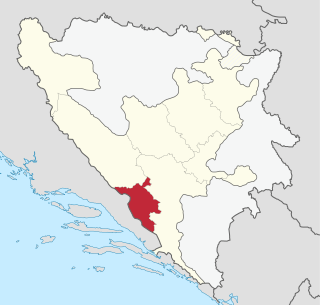
The West Herzegovina Canton is one of the cantons of the Federation of Bosnia and Herzegovina. The West Herzegovina Canton is in the Herzegovina region in the southwest of Bosnia and Herzegovina. Its seat of government is in Široki Brijeg, while other municipalities within the Canton are Grude, Ljubuški and Posušje. It has 94,898 inhabitants, of whom more than 98% are ethnic Croats.

The Sacred Heart Cathedral is a Catholic church in Sarajevo; commonly referred as the Sarajevo Cathedral, it is the largest cathedral in Bosnia and Herzegovina. It is the seat of the Archbishop of Vrhbosna, currently Cardinal Vinko Puljić, and center of Catholic worship in the city. The Cathedral is located in the city's Old Town district.

The coat of arms of Malta is the national coat of arms of the country of Malta.
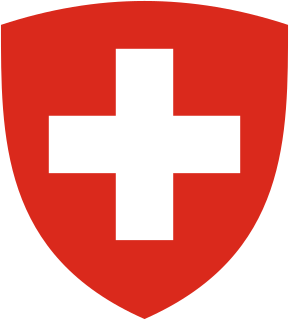
The coat of arms of the Swiss Confederation shows the same white-on-red cross as the flag of Switzerland, but on a heraldic shield instead of the square field.
There is currently no official coat of arms for the Federation of Bosnia and Herzegovina. The federation is part of the state of Bosnia and Herzegovina.
This article is a vexillological summary of all flags and symbols in current use by the island nation of Malta. More information on the history of the various flags and emblems, as well as on their equivalents which are no longer in use, is found on the specific articles, linked to in the subtitle headings.
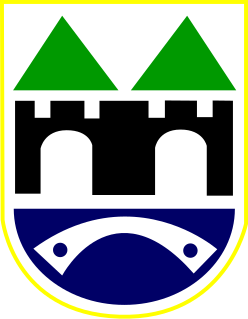
The Coat of Arms of Sarajevo is the coat of arms of the city of Sarajevo, the capital of Bosnia and Herzegovina.

The coat of arms of Kropyvnytskyi is one of the city's symbols reflecting its past and the controversies of its history.
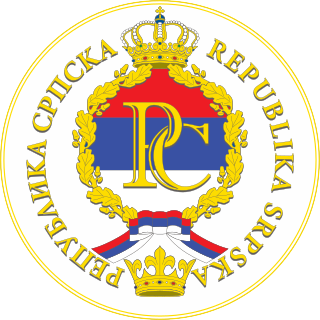
The Seal of Republika Srpska with the description: the flag of Republika Srpska and the Cyrillic letters "РС" ("RS"), the red-blue-white tricolor are in the center of the seal, twisted with the golden Oak leaves, a traditional pre-Christian symbol sacred to most Slavs. On the edge of the seal there is an inscription Republika Srpska. The open crown of Kotromanić is shown in the bottom of the seal and the seal itself is topped with a heraldic royal crown.

Attributed arms are Western European coats of arms given retrospectively to persons real or fictitious who died before the start of the age of heraldry in the latter half of the 12th century. Arms were assigned to the knights of the Round Table, and then to biblical figures, to Roman and Greek heroes, and to kings and popes who had not historically borne arms. Each author could attribute different arms for the same person, but the arms for major figures soon became fixed.

The Pavlović family, also Radinović or Radenović, or Radinović-Pavlović, whose ancestors Jablanići got their name after their family estate at Jablan grad, was a medieval Bosnian family, whose feudal possessions extended from the Middle and Upper Drina river in the eastern parts of medieval Bosnia to south-southeastern regions of the Bosnian realm in Hum, and Konavle at the Adriatic coast. The family official residence and seat was at Borač and later Pavlovac, above the Prača river canyon, between present-day Prača, Rogatica and Goražde in Bosnia and Herzegovina.

The coat of arms of Enkhuizen has been the coat of arms ever since Enkhuizen received borough rights in 1355. The coat of arms was acknowledged in 1816 by the High Council of Nobility, the coat of arms has not been changed ever since.
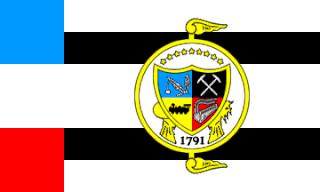
The flag of Knoxville, Tennessee consists of an upper section that begins with a blue square followed by horizontal bars of white and black. The lower section contains a red square also followed by horizontal bars of white and black. In the middle section of white, a golden winged wheel is emblazoned with the shield of the City. The escutcheon is supported by a sheaf of corn and a sheaf of wheat. The year 1791 appears below the shield and a crest of nine gold stars (mullets) surmounts it.
















